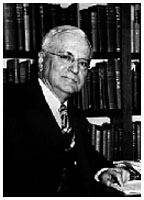
|
March 8, 2006: From the Editor
Edward S. Corwin (Princveton University Archives) |
This issue brings together two Princeton moments relating to the Supreme Court. One, of course, is the appointment of Samuel A. Alito Jr. ’72 as an associate justice — the first Tiger on the court since John Marshall Harlan ’20. In one article, PAW writer Mark F. Bernstein ’83 reports on Alito’s time on campus and some of the influences that shaped his views. Bernstein spoke to many of Alito’s friends and classmates, though he was unable to interview Alito, who had not yet been confirmed.
In our second court-related feature, Mark O’Brien ’73, a preceptor in the University’s “Constitutional Interpretation” undergraduate course, explores the role of legendary Princeton professor Edward S. Corwin in Franklin Delano Roosevelt’s 1937 plan to pack the court — a plan F.D.R. hoped would smooth the way to implementation of his New Deal agenda by changing the composition of that pesky high court.
Corwin, one of Woodrow Wilson 1879’s original preceptors, went on to become the third McCormick Professor of Jurisprudence and to teach “Constitutional Interpretation.” He died in 1963, but continues to be regarded as one of the finest constitutional scholars in the nation’s history. As a witness speaking in favor of court-packing before the Senate Judiciary Committee, however, his performance was not as stellar. O’Brien explains in his article that in only about three hours of testimony, the professor helped to bury the court-packing plan he had helped formulate.
The lasting significance of Corwin’s scholarship has been in evidence recently, however. Over the last year, his name has come up in blogs, newspaper columns, and government reports in connection with President Bush’s use of executive power. It was Corwin who famously described the Constitution as an “invitation to struggle” among the branches of government, an intentional tension; today, bloggers, pundits, and scholars cite Corwin as they debate how that struggle is being waged.
The Mudd Manuscript Library houses Corwin’s manuscripts and letters; among them is the draft of a 10-minute radio talk he gave in 1942. It was part of a series called “What Freedom Means” — as the network described it, a series “that brings to you in your homes the thoughts and voices of men and women who have distinguished themselves as leaders in public life.” It may be difficult today to imagine Americans sitting by their radios to hear a professor quote Jefferson and Montesquieu as he expounds on constitutional versus civil liberty, but listen they did.
At the end of his talk, Corwin discusses political liberty, “which
may be defined as the right which each individual member of a democracy
enjoys in determining the acts and policies of his government,”
and which Corwin recognized as “an ideal to be realized.”
He concluded: “Thus democracy and the worth of the individual stand
together. That they may continue to stand is the grand objective of our
war effort and the prayer of us all.” ![]()
![]()
Marilyn H. Marks *86
mmarks@princeton.edu

